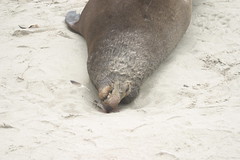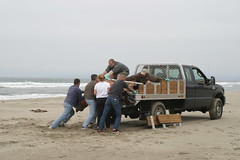Third Order Effects
 The equation is simple, but the results are profound.
The equation is simple, but the results are profound.
Warmer oceans trigger larger and larger algae blooms along the North American west coast, and this year's bloom is massive. Such large algae blooms release domoic acid, which acts as a toxin, poisoning the fish and shellfish that feed on the algae. In turn, the birds and sea mammals that feed on the fish get poisoned by the concentrated acid. This year, sea life along the California coast appears to be dying in record numbers.
Sea life including elephant seals, such as the two found dead on the beach at Pajaro Dunes, where I'm visiting with my wife's family this weekend. Researchers from the Long Marine Lab at UC Santa Cruz came out to retrieve the bodies today, and I ended up helping them (as seen in these photos at Flickr). They told me that, although the seals will need autopsies, domoic acid poisoning is the likely culprit.
The algae population increases or "blooms" every year as the ocean waters warm but this year's bloom seems early, extensive and "very, very thick," said David Caron, who teaches in the biological sciences department at University of Southern California."In five years of study I have not seen a bloom this large at this particular time of year," Caron said.
Human activity, particularly nitrogen from fertilizer waste and global warming, contribute to the size of the algae blooms. This will, in time, come back to haunt us.
Many scientists agree that increases in algal blooms in California and around the world are caused by a combination of factors, including agricultural run-off, oceanographic properties, and global warming. [...] Scientists first saw domoic acid poisoning in 1998, when over 70 sea lions died in one weekend. "We thought at the time that it was linked to the fact that it was an El Nino year, but we've seen it every year since then," says Frances Gulland of The Marine Mammal Center in Sausalito, California. "It's a big mystery."In the last five years, over 1000 animals have died from domoic acid poisoning, and there has been an increase in the number and extent of harmful algal blooms that produce the compound.
"Sea lions eat the same foods we do, but more of them – foods like anchovies, squid, salmon, and mussels – we may see the effects of domoic acid in them before we see it people," says Gulland. Researchers are already seeing signs of serious health problems, such as miscarriages and epilepsy, in sea lions. "Sea lions may be an early warning sign for humans," she says.
It's not (yet) every day that one gets to pick up the body of a "canary in a coal mine."







Comments
Sorry you had to deal with that on our vacation. Sobering.
Posted by: Howard Berkey | June 2, 2007 7:10 PM
Er, *your* vacation, sorry :)
Posted by: Howard Berkey | June 2, 2007 7:10 PM
Actually, it was pretty interesting -- and definitely memorable.
Posted by: Jamais Cascio | June 2, 2007 7:25 PM
Domoic acid sounds relatively nasty too, based on wikipedia anyway. Damn.
Posted by: Howard Berkey | June 2, 2007 10:24 PM
What if we are all magically whisked away to some second-life-uberverse prior to our suffocating in said coal mine?
Posted by: Brock | June 5, 2007 9:00 AM
There is a problem with the hypothesis, namely the fact that for the past several months at least the sea surface temperatures off the coast of California have in fact been lower than normal, according to satellite data from NOAA.
http://www.osdpd.noaa.gov/PSB/EPS/SST/climo.html
Posted by: Ken Robinson | June 11, 2007 1:05 PM
Thanks for the link, Ken. I agree -- the temperature data doesn't match the assertions from the marine scientists about the algae.
Question: how deep does the NOAA temperature data go (below the surface of the ocean, I mean), and how deep into the ocean do algae blooms appear? Are surface temperature data the right ones to look at for this?
Posted by: Jamais Cascio | June 11, 2007 1:12 PM
Jeremy Jackson, a marine ecologist and paleontologist at the Scripps Institution calls this "the rise of slime" -- essentially a de-evolution of the ocean ecosystem.
There was an outstanding series last year in the LA Times that covered the story pretty well, and with good pix. http://www.latimes.com/news/local/oceans/la-oceans-series,0,7842752.special
There's a longer interview with him here:
http://cbc.amnh.org/symposia/archives/expandingthearc/speakers/transcripts/jackson-text.html
Posted by: NRDC | June 14, 2007 7:45 AM